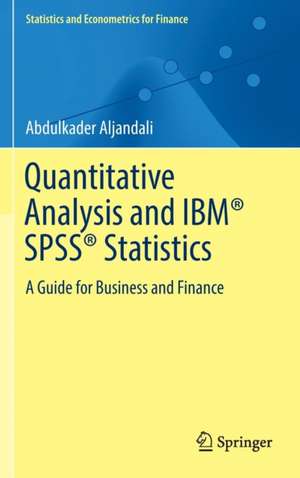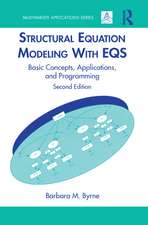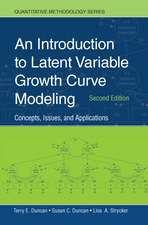Quantitative Analysis and IBM® SPSS® Statistics: A Guide for Business and Finance: Statistics and Econometrics for Finance
Autor Abdulkader Aljandalien Limba Engleză Hardback – 15 noi 2016
This guide is for practicing statisticians and data scientists who use IBM SPSS for statistical analysis of big data in business and finance. This is the first of a two-part guide to SPSS for Windows, introducing data entry into SPSS, along with elementary statistical and graphical methods for summarizing and presenting data. Part I also covers the rudiments of hypothesis testing and business forecasting while Part II will present multivariate statistical methods, more advanced forecasting methods, and multivariate methods.
IBM SPSS Statistics offers a powerful set of statistical and information analysis systems that run on a wide variety of personal computers. The software is built around routines that have been developed, tested, and widely used for more than 20 years. As such, IBM SPSS Statistics is extensively used in industry, commerce, banking, local and national governments, and education. Just a small subset of users of the package include the major clearing banks, the BBC, British Gas, British Airways, British Telecom, the Consumer Association, Eurotunnel, GSK, TfL, the NHS, Shell, Unilever, and W.H.S.
Although the emphasis in this guide is on applications of IBM SPSS Statistics, there is a need for users to be aware of the statistical assumptions and rationales underpinning correct and meaningful application of the techniques available in the package; therefore, such assumptions are discussed, and methods of assessing their validity are described. Also presented is the logic underlying the computation of the more commonly used test statistics in the area of hypothesis testing. Mathematical background is kept to a minimum.
| Toate formatele și edițiile | Preț | Express |
|---|---|---|
| Paperback (1) | 383.12 lei 6-8 săpt. | |
| Springer International Publishing – 5 iul 2018 | 383.12 lei 6-8 săpt. | |
| Hardback (1) | 390.25 lei 6-8 săpt. | |
| Springer International Publishing – 15 noi 2016 | 390.25 lei 6-8 săpt. |
Preț: 390.25 lei
Nou
Puncte Express: 585
Preț estimativ în valută:
74.68€ • 81.10$ • 62.73£
74.68€ • 81.10$ • 62.73£
Carte tipărită la comandă
Livrare economică 23 aprilie-07 mai
Preluare comenzi: 021 569.72.76
Specificații
ISBN-13: 9783319455273
ISBN-10: 3319455273
Pagini: 220
Ilustrații: XXI, 184 p. 143 illus., 119 illus. in color.
Dimensiuni: 155 x 235 x 13 mm
Greutate: 0.47 kg
Ediția:1st ed. 2016
Editura: Springer International Publishing
Colecția Springer
Seria Statistics and Econometrics for Finance
Locul publicării:Cham, Switzerland
ISBN-10: 3319455273
Pagini: 220
Ilustrații: XXI, 184 p. 143 illus., 119 illus. in color.
Dimensiuni: 155 x 235 x 13 mm
Greutate: 0.47 kg
Ediția:1st ed. 2016
Editura: Springer International Publishing
Colecția Springer
Seria Statistics and Econometrics for Finance
Locul publicării:Cham, Switzerland
Cuprins
1 Getting Started with SPSS.- 2 Graphics and Introductory Statistical Analysis of Data.- 3 Frequencies and Crosstabulations.- 4 Coding, Missing Values, Conditional and Arithmetic Operations.- 5 Hypothesis Tests Concerning Means.- 6 Nonparametric Hypothesis Tests.- 7 Bivariate Correlation and Regression.- 8 Multivariate Regression.- 9 Logistic Regression.
Notă biografică
Abdulkader Aljandali, Ph.D., is a Senior Lecturer in Quantitative Finance and Business Forecasting at Regent’s University London. He acts as a visiting professor at overseas institutions in Canada, France, and Morocco.
Textul de pe ultima copertă
This guide is for practicing statisticians and data scientists who use IBM SPSS for statistical analysis of big data in business and finance. This is the first of a two-part guide to SPSS for Windows, introducing data entry into SPSS, along with elementary statistical and graphical methods for summarizing and presenting data. Part I also covers the rudiments of hypothesis testing and business forecasting while Part II will present multivariate statistical methods, more advanced forecasting methods, and multivariate methods.
IBM SPSS Statistics offers a powerful set of statistical and information analysis systems that run on a wide variety of personal computers. The software is built around routines that have been developed, tested, and widely used for more than 20 years. As such, IBM SPSS Statistics is extensively used in industry, commerce, banking, local and national governments, and education. Just a small subset of users of the package include the major clearing banks, theBBC, British Gas, British Airways, British Telecom, the Consumer Association, Eurotunnel, GSK, TfL, the NHS, Shell, Unilever, and W.H.S.
Although the emphasis in this guide is on applications of IBM SPSS Statistics, there is a need for users to be aware of the statistical assumptions and rationales underpinning correct and meaningful application of the techniques available in the package; therefore, such assumptions are discussed, and methods of assessing their validity are described. Also presented is the logic underlying the computation of the more commonly used test statistics in the area of hypothesis testing. Mathematical background is kept to a minimum.
Abdulkader Aljandali, Ph.D., is a Senior Lecturer in Quantitative Finance and Business Forecasting at Regent’s University London. He acts as a visiting professor at overseas institutions in Canada, France, and Morocco.
IBM SPSS Statistics offers a powerful set of statistical and information analysis systems that run on a wide variety of personal computers. The software is built around routines that have been developed, tested, and widely used for more than 20 years. As such, IBM SPSS Statistics is extensively used in industry, commerce, banking, local and national governments, and education. Just a small subset of users of the package include the major clearing banks, theBBC, British Gas, British Airways, British Telecom, the Consumer Association, Eurotunnel, GSK, TfL, the NHS, Shell, Unilever, and W.H.S.
Although the emphasis in this guide is on applications of IBM SPSS Statistics, there is a need for users to be aware of the statistical assumptions and rationales underpinning correct and meaningful application of the techniques available in the package; therefore, such assumptions are discussed, and methods of assessing their validity are described. Also presented is the logic underlying the computation of the more commonly used test statistics in the area of hypothesis testing. Mathematical background is kept to a minimum.
Abdulkader Aljandali, Ph.D., is a Senior Lecturer in Quantitative Finance and Business Forecasting at Regent’s University London. He acts as a visiting professor at overseas institutions in Canada, France, and Morocco.
Caracteristici
Utilizes the popular and accessible IBM SPSS Statistics software package to teach data analysis for business and finance in a step-by-step approach A comprehensive, in-depth guide, especially relative to the competition Explains the statistical assumptions and rationales underpinning application of the SPSS package, instead of simply presenting techniques More than 100 color graphs and figures Includes directed download of the software IBM SPSS Statistics 22. Includes supplementary material: sn.pub/extras

















